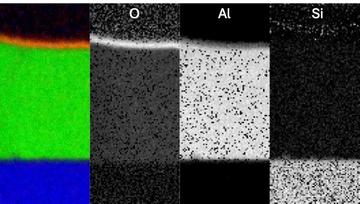
EELS map of the cross-section of an Al device on a Si substrate taken at the ePSIC facility.
Superconducting qubits based on Josephson junctions are one of the leading technologies for realising practical quantum computers. Although advancement in engineering the electromagnetic environment of qubits has led to relaxation times in the milliseconds range, further improvement is required for error correction schemes. Therefore, understanding the sources of dissipation and eliminating them either through clever device design, improved fabrication techniques or smarter materials selection is of prime importance to advancing superconducting quantum technologies. A key culprit contributing to dissipation is known to be two-level systems that are believed to originate from defects in the surface oxides and tunnel barrier. However, very little is known about the nature of these defects or how they can be avoided. This collaborative project between the Materials and Physics departments will involve using a combination of analytic techniques including transmission electron microscopy, x-ray spectroscopy and atomic force microscopy to correlate the chemistry and microstructure of the multilayer structures with device performance. The effect of materials selection and processing procedures (such as cleaning/patterning steps and deposition parameters) will be correlated with device performance.